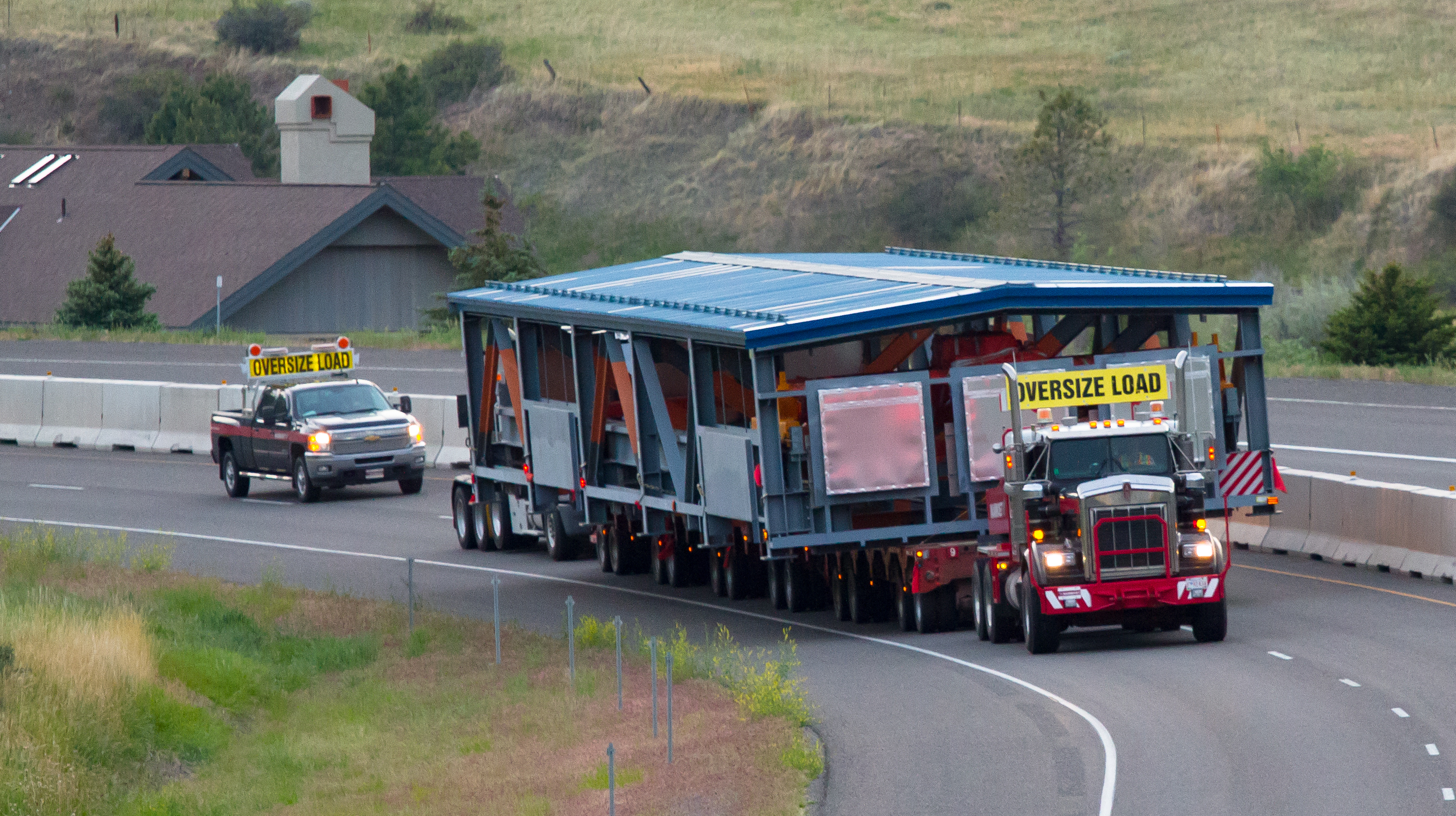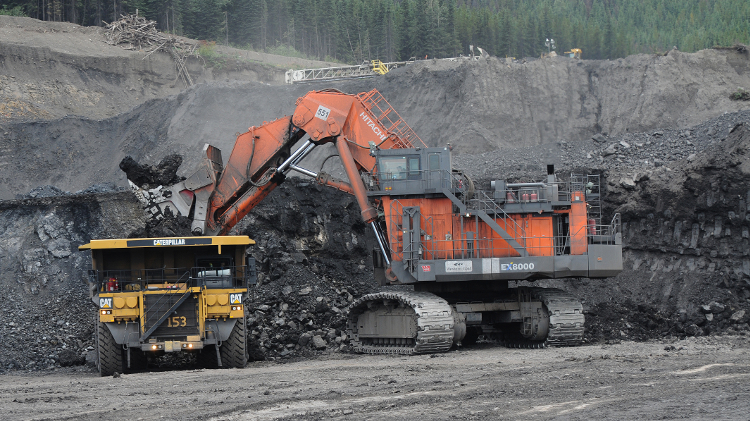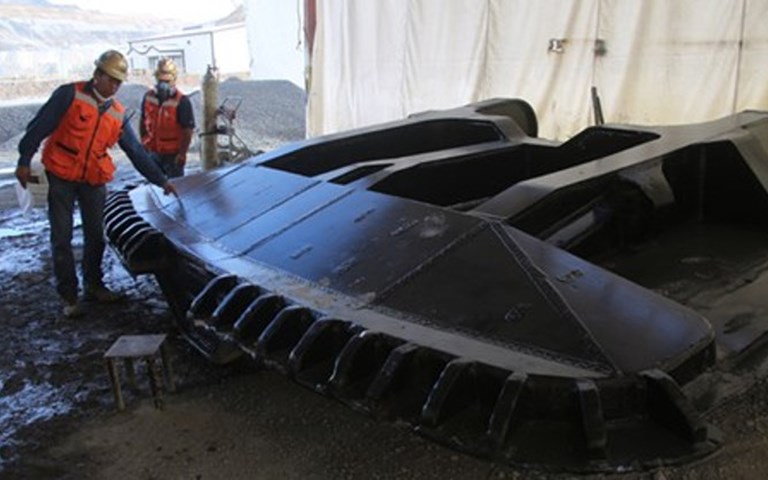Moises Castillo inspects a dipper door manufactured at Goldcorp's Peñasquito mine in Mexico | Courtesy of Goldcorp
Since it entered commercial production in 2010, Goldcorp’s Peñasquito mine has been operating four Bucyrus 495 electric rope shovels – each a nearly 1,500-tonne mammoth able to lift 100 tonnes of rock in a single scoop. Few of the local employees from the arid state of Zacatecas in north-central Mexico, had ever seen such a large beast. Maintenance quickly became quite a challenge for the welding department, which was unfamiliar with most of the components.
The contact point of the Bucyrus 495 became a major source of stress for welders at Peñasquito. Located on the bottom of the dipper, there is a huge, trapdoor-like panel that they found tended to crack prematurely. Its size makes it hard to handle: the dipper door alone is five metres high, 5.5 metres wide and weighs up to eight tonnes.
“We did not know these components,” says Moises Castillo, the supervisor’s assistant at the welding shop. “Cracks soon started to appear that were worrying.” In the first year, rope shovels had to be shut down so that welders could seal the cracks on the spot. These interruptions were costly. “We had to stop operations for as long as 10 hours, a full shift sometimes, with many welders on site,” Castillo recalls.
One weak link
Managers at the mine loathed these blips in their operations, and they soon ordered a brand new replacement door from Bucyrus’ manufacturing facility in Milwaukee. But it was a costly fix: the price for the door was US$600,000.
It soon became obvious that one replacement door would not cut it. The welding department has 103 technicians, divided into three shifts. A single cracked door would mobilize four of them for an unpredictable period of time, depending on the damage. “In the first few years, fixing a door could take us as long as 20 to 25 man-hours, which affected our availability for other maintenance work,” recalls Julio Jardon, maintenance manager at Peñasquito.
As soon as one door was fixed, another one would fail, at a rate that was only increasing due to fatiguing parts, adding stress to the welding department. “It disrupted our working schedule,” says Castillo. “We would make working plans, but each time these repairs would just override them.”
A flash of inspiration
Global circumstances began working against Goldcorp. The price of gold – which had reached its US$1,800 peak in 2011 – started to decline during the winter of 2013 and soon fell to less than US$1,300. Moreover, expenses at Peñasquito had boosted all-in sustaining costs to nearly US$915 per ounce. Buying new doors from Milwaukee soon became out of the question. “We had found an intermediary based in Wyoming that would sell us doors for US$450,000, but that was still too high,” says Jardon. “Moises would come to me and ask me to order new doors, since the ones that we had were all cracked up and wouldn’t last for long. And with the company’s focus on driving down costs, the expensive purchases were out of the question.”
That is when Castillo had a stroke of brilliance. “Repairs were so intensive and were carried out on so many different door components that we realized we were almost making the doors anew,” he says. “At one point I thought, ‘Why not build them ourselves then?’”
The suggestion was music to Jardon’s ears. Departments had just been asked to find new strategies to cut down their costs. “It was a coincidence,” says Castillo. “The context gave us the opportunity to put our idea to the test.”
Castillo was aware that success would be critical, so he took his time. “We knew that we wouldn’t be allowed a second chance,” he says. “The manager would not let us carry out experiments over and over again on a 1,500-tonne shovel.”
It took about a hundred days, or roughly 6,000 man-hours for the welding shop to design its first door. Not every part could be made on site; two key components had to be ordered from local providers. For one, the department did not have the equipment to roll a two-inch thick sheet of steel. Neither could they machine hinges and bolts of the large diameter required. However, all the other parts were made in house, assembly was done at the mine and by the end of last October the first door was installed. It is still part of the operation cycle.
“It was a huge success here, because the door has been improved,” says Jardon. “It is lighter, we improved the design and we added reinforcements to the weaker parts so that it can last longer.” Also, the original doors had a thick liner that tended to clog in the loads. “We removed the liner so that the sheet is thinner,” he adds.
Riding a wave of confidence
The welding department now has a little more room to maneuver. “When we see that a door is not worth being fixed anymore, we can just dump it without the stress of suddenly having to spend extra hours on it,” says Castillo. “We can plan our schedule better. You don’t see our welders having to climb up the shovel on site during maintenance time. We just agree on when the door will be replaced and put it in the schedule.”
The gains are huge. According to Goldcorp’s estimates, the cost of building a door in-house is as low as US$95,000. Up to US$1.2 million will be saved in 2014 alone. The second door is about to be finished, says Castillo. A third one could be on order for 2015.
Castillo is positive about the chance that the initiative could be extended to other applications. “In our department, we are looking for savings on other components as well,” he says. “We are quite versatile in what we can cut and weld, not only in the shovel bucket but in structures such as hallways, handrails and platforms. For complex mechanical pieces, it is all about precision, and parts need to comply with very high standards. But when it comes to structures, there are many opportunities.”




